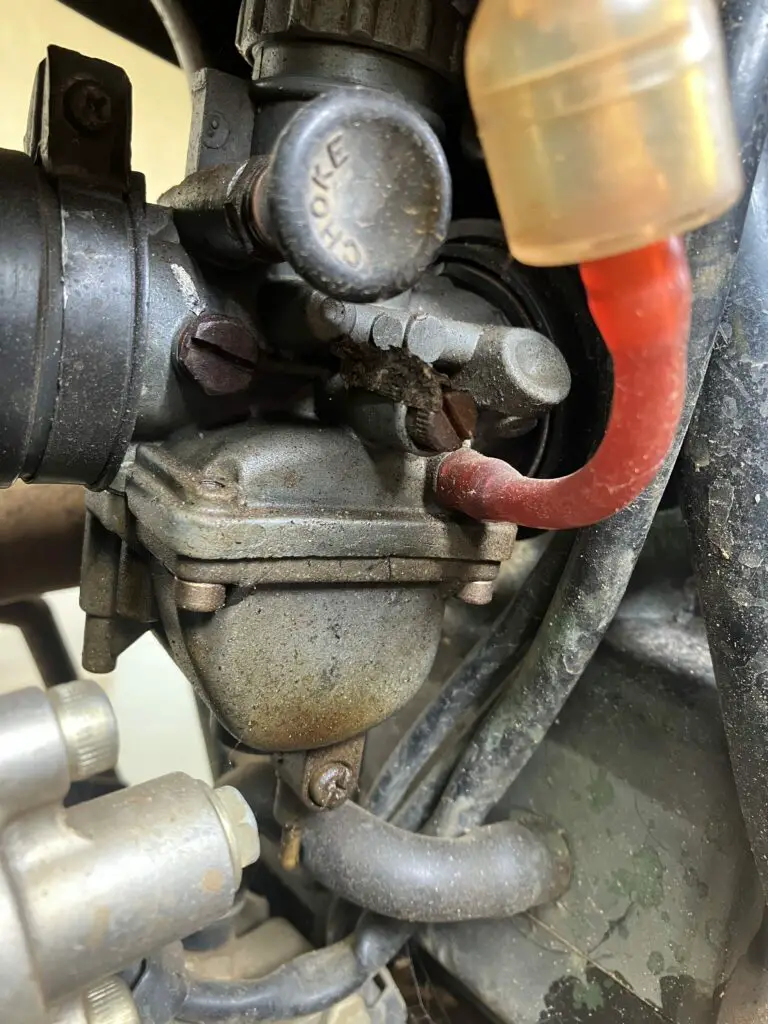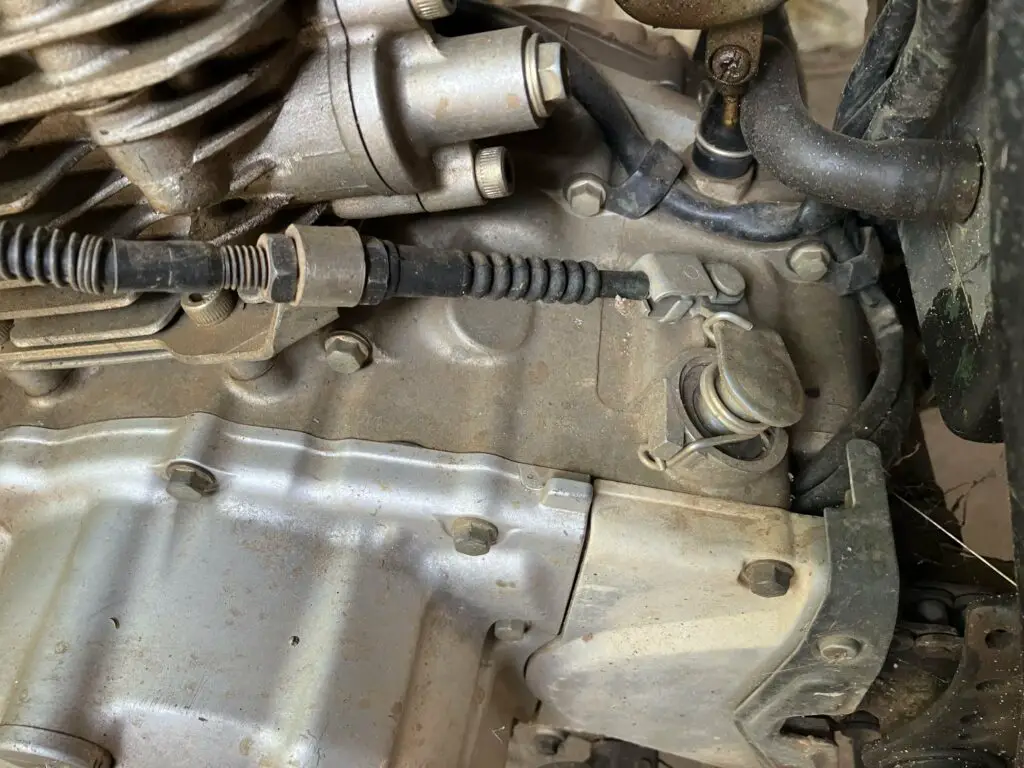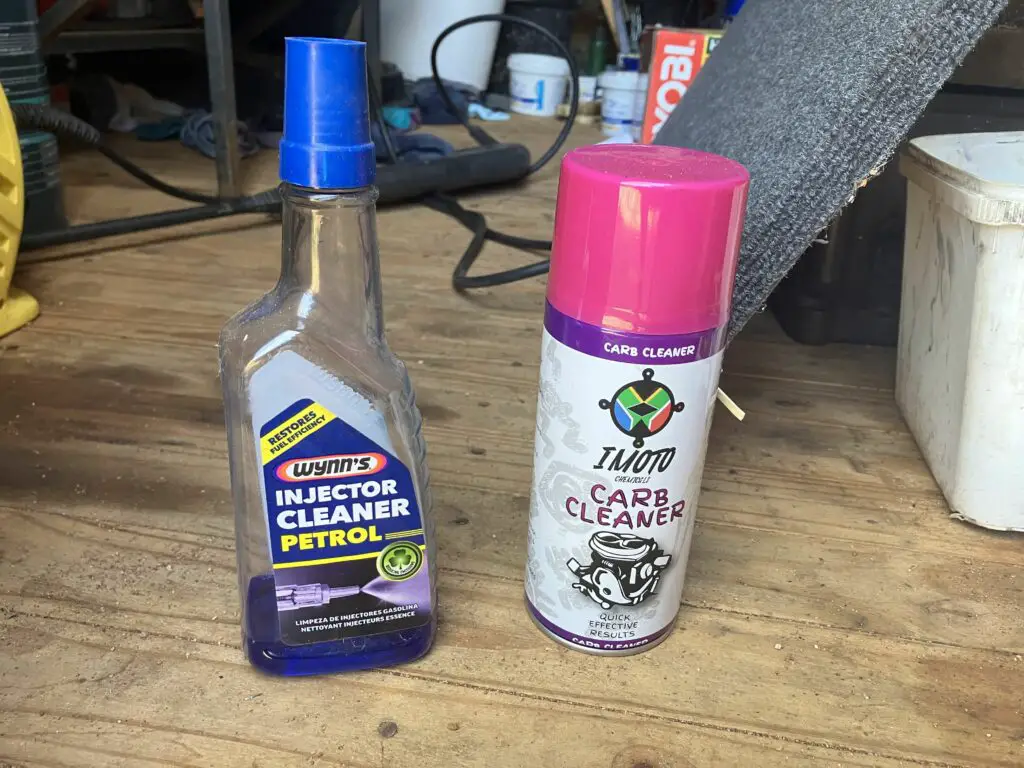There are few things more frustrating than a motorcycle that stalls each time you come to a stop, especially in rush hour traffic seconds before the light turns green. Ask me how I know! 🙂
A motorcycle may stall when you stop if the idle speed is set too low or if the clutch is not disengaging correctly. A dirty or clogged carburetor (or fuel injectors) or a vacuum leak can restrict fuel flow and cause stalling when you stop. Faulty ignition systems, malfunctioning sensors, and blocked air filters can also lead to engine dying.
As with many issues relating to a motorcycle engine not running properly, there are several potential causes for a motorcycle to stall when the rider stops. Luckily, it is often something simple that you can fix yourself. Here’s a list of the seven more common reasons for a bike to die when you stop:
- Idle speed set too low: If the idle speed is set too low, the engine may not receive enough fuel to keep running when the throttle is closed, causing it to stall.
- Clutch engagement issue: If the clutch is not fully disengaging, it can cause the engine to stall when stopping, as the transmission is still trying to drive the motorcycle forward.
- Dirty or clogged carburetor/fuel injection system: A dirty carburetor or clogged fuel injectors can restrict fuel flow, causing the engine to stall when the throttle is closed.
- Vacuum leak: A vacuum leak can cause the motorcycle to stall at idle due to an improper air-fuel mixture.
- Faulty ignition system: Problems with the ignition system, such as a failing ignition coil or spark plug, can lead to poor combustion and engine stalling.
- Malfunctioning sensors or electronics: Issues with sensors or electronic components, such as the throttle position sensor, can cause incorrect fuel delivery and engine stalling.
- Blocked air filter: A dirty or clogged air filter can restrict airflow, causing the engine to stall when stopping.
In this article, we’re going to have a closer look at the three more common reasons why your motorcycle stalls when you come to a stop, as well as how you can fix it yourself without any mechanical background. Then we’ll take a quick look at the four less common causes for your bike to die on you when you stop.
Before we continue… are you sure your bike is safe to ride? Join my mailing list and get a FREE copy of my e-Guide on HOW TO KEEP YOUR BIKE SAFE (Without any mechanical background).
Low Idle Speed Causing Bike to Die When You Stop
A motorcycle’s engine requires a proper balance of fuel and air (14.7 to 1 in terms of weight to be exact) to maintain a smooth and consistent idle. Idle speed is the number of revolutions per minute (RPM) the engine runs when the throttle is fully closed, and the motorcycle is stationary.
When a motorcycle’s idle speed is set too low, it can lead to stalling when the rider comes to a stop. This is because the engine does not receive enough fuel to keep running when the throttle is closed, and the RPM drops below the minimum level required for the engine to maintain a stable idle.
There are several reasons why a motorcycle may have a low idle speed. It could be due to an improper adjustment made during maintenance or simply because the motorcycle’s idle speed was never correctly set. Other factors, such as changes in altitude or ambient temperature, can also affect idle speed. As the motorcycle’s engine becomes warmer, the idle speed may need to be adjusted to maintain smooth operation.
If you’re experiencing stalling issues when stopping, it’s essential to address the problem to ensure the motorcycle operates safely and efficiently. There’s nothing worse than a bike that stalls at a busy intersection, just as the light turns green!
Fortunately, adjusting the idle speed is usually a straightforward process that does not require an extensive mechanical background.

To correct a low idle speed, follow these steps:
- Make sure the motorcycle is on level ground and in a well-ventilated area. Start the engine and let it warm up to its normal operating temperature.
- Locate the idle adjustment screw, which is typically found on the side of the carburetor or throttle body. Consult your motorcycle’s owner’s manual or look for online resources to help you identify the correct location for your specific model, as there are often another screw (the air-fuel mixture screw) too.
- Use a flat-head screwdriver or the appropriate tool to turn the idle adjustment screw. Turning the screw (clockwise on most bikes) will increase the idle speed, while turning it counterclockwise will decrease the speed. The adjustment may be reversed, but you’ll notice it immediately.
- Observe the tachometer (if your bikes has one) or listen to the engine sound to determine the current idle speed. Adjust the screw until the engine maintains a smooth and consistent idle. The recommended idle speed can usually be found in your motorcycle’s owner’s manual.
- Once you’ve reached the desired idle speed, let the engine run for a few minutes to ensure it remains stable. Blip the throttle a few times to ensure it settles at the correct idle speed.
By following these steps, you can correct a low idle speed and prevent your motorcycle from stalling when you come to a stop. If the motorcycle continues to stall, read on.
DISCLAIMER (for legal purposes, you know…): Always refer to your motorcycle’s owner’s manual for specific guidance and recommended maintenance practices.
Clutch Engagement Causing Bike to Die When You Stop
A clutch engagement issue can cause a motorcycle to stall when the rider comes to a stop because the clutch is responsible for connecting and disconnecting the engine from the transmission. When operating correctly, the clutch allows the rider to smoothly transfer power from the engine to the rear wheel, change gears, and stop without stalling the engine.
The clutch system consists of several components, such as the clutch lever, clutch cable, and clutch plates. When the clutch lever is pulled, the clutch plates disengage, separating the engine from the transmission. This allows the engine to idle without driving the motorcycle forward. If the clutch does not fully disengage, the engine continues to transfer power to the transmission, causing the motorcycle to stall when stopping.
There are a few potential reasons for a clutch engagement issue:
- Clutch cable adjustment: The clutch cable may be improperly adjusted, preventing the clutch from fully disengaging. Usually, a cable that is too slack will cause the bike to stall when you stop. To correct this, follow the steps below:
- Locate the clutch cable adjuster, usually found near the clutch lever or along the cable.
- Loosen the locknut and adjust the cable tension by turning the adjuster. The goal is to achieve a small amount of free play in the clutch lever before it begins to disengage the clutch.
- Tighten the locknut and test the clutch operation. If the issue persists, consult a qualified mechanic.
- Worn clutch plates: Over time, clutch plates can wear out and lose their ability to fully disengage. In this case, a clutch replacement is necessary. Replacing a clutch can be a complex task that may require specialized tools and expertise. You might have to call your mechanic for this one, unless you feel like getting your garage floor full of oil.
- Hydraulic clutch issues: Some motorcycles have a hydraulic clutch system. If there is a problem with the hydraulic fluid or master/slave cylinder, the clutch may not fully disengage. Check for leaks and that your clutch fluid reservoir is full. If not, maybe time to visit that mechanic.

It is important that your motorcycle’s clutch works properly, so if you are unsure, ask for help.
Dirty Carb or Fuel Injectors Causing Bike to Die When You Stop
A dirty carburetor or fuel injectors can cause a motorcycle to stall when the rider comes to a stop because these components play a crucial role in delivering the correct air-fuel mixture to the engine for combustion.
The carburetor or fuel injectors ensure that the engine receives the right amount of fuel based on throttle position and engine load. When the carb jets or fuel injectors become dirty or clogged, they can restrict fuel flow, causing an improper air-fuel mixture that leads to stalling when the throttle is closed.
Carburetors and fuel injectors can become dirty over time due to the buildup of fuel deposits, dirt, or other contaminants. This buildup can lead to erratic engine performance, reduced fuel efficiency, and stalling when stopping. This is quite a common problem on older bikes, so expect it if you buy second-hand. It can be very frustrating, but don’t give up. To clean the fuel system, follow these steps:
For carbureted motorcycles:
- Purchase a carburetor cleaner from an auto parts store. This cleaning solution is specifically designed to break down and remove fuel deposits and dirt from the carburetor.
- Turn off the engine and locate the carburetor on your motorcycle. Consult your owner’s manual for the exact location and removal instructions, as it can vary between models.
- Remove the air filter and spray the carburetor cleaner directly into the carburetor, focusing on the throttle body, choke, and any visible jets or openings. Follow the cleaner’s instructions regarding application and wait time. You can also drain the carb float bowl by removing the drain screw at the bottom, and then filling the carb with carb cleaner via the inlet hose (from the gas tank).
- Reinstall the air filter and start the engine. Allow the motorcycle to idle for a few minutes, then test ride to ensure the issue is resolved.

For fuel-injected motorcycles:
- Purchase a fuel injector cleaner from an auto parts store. This cleaning solution is designed to be mixed with gasoline and will help remove deposits from the fuel injectors as the engine runs.
- Follow the instructions on the fuel injector cleaner packaging to determine the correct amount to add to your motorcycle’s fuel tank. Fill the tank with gasoline and mix the cleaner according to the recommended ratio.
- Start the engine and let it idle for a few minutes. This will allow the cleaning solution to circulate through the fuel system and begin breaking down deposits.
- Take the motorcycle for a test ride to help further clean the fuel injectors. Monitor the engine’s performance to determine if the stalling issue is resolved.
Regular maintenance, such as replacing the air filter and using quality fuel, can help prevent carburetor and fuel injector issues. Also, take care when filling the bike from containers such as jerry cans or fuel cells. To find out how to carry extra fuel on your bike, check out this post I wrote.
Four More Reasons Why Your Bike Dies When You Stop
If you’ve tried adjusting your idle a bit higher, checked that your clutch is disengaging properly, and you’ve cleaner your carburetor or fuel injectors, you might want to read on. Here are four more reasons why your motorcycle may stall when you come to a stop.
Hang in there! We’ll get to the bottom of this very frustrating situation!
Vacuum Leak
A vacuum leak occurs when there is an unintended opening in the intake manifold or associated hoses, allowing excess air to enter the engine. This causes an improper air-fuel mixture, leading to poor combustion and stalling when the rider comes to a stop.
To correct a vacuum leak, follow these steps:
- Inspect the intake manifold, vacuum hoses, and connections for cracks, damage, or loose connections.
- Listen for a hissing sound near the engine, which may indicate a vacuum leak.
- Use a can of carburetor cleaner or starting fluid to spray around the suspected leak area while the engine is running. If the engine’s idle changes, you’ve likely found the leak.
- Repair or replace damaged parts as needed.
Faulty Ignition System
A faulty ignition system can cause poor combustion and engine stalling due to issues with the ignition coil, spark plugs, or spark plug wires. These components are responsible for creating and delivering the spark necessary for combustion.
To correct a faulty ignition system, follow these steps:
- Inspect the spark plug wires for damage, and ensure they are securely connected.
- Remove and examine the spark plugs for excessive wear, carbon buildup, damage, or incorrect gap between the top and the electrode. Replace, clean, or adjust them if necessary.
- Test your ignition system as per this post. The spark should be right blue, not yellow or orange.
Malfunctioning Sensors or Electronics
Modern motorcycles rely on various sensors and electronic components to regulate the engine’s performance. Issues with these components, such as a faulty throttle position sensor or oxygen sensor, can cause incorrect fuel delivery and stalling.
To correct malfunctioning sensors or electronics, follow these steps:
- Consult your motorcycle’s owner’s manual to identify and locate relevant sensors.
- Visually inspect the sensors and their wiring for damage or loose connections.
- If you suspect a faulty sensor, consult a qualified mechanic that has the correct diagnostic tools to find the fault and fix it.
Blocked Air Filter
A dirty or clogged air filter can restrict airflow to the engine, causing an improper air-fuel mixture and stalling when stopping.
To correct a blocked air filter, follow these steps:
- Locate the air filter, usually found just behind the carburetor or throttle body. Consult your owner’s manual for the exact location and removal instructions, especially if you ride a Ducati Desert X (to you, I say “Good luck!”)
- Remove the air filter and inspect it for dirt, debris, or damage.
- If the filter is reusable, clean it with a suitable air filter cleaner and allow it to dry completely before reinstalling. If it’s disposable, replace it with a new one.
- Reinstall the air filter and ensure it’s securely in place. Make 100% sure no dirt gets into the engine side of the air filter housing.
Performing regular maintenance on your motorcycle, and inspecting the important bits each time you wash your bike (which should not be only once a decade) will reduce the chances of idling issues popping up when you are not in the mood (are we ever?).
Conclusion
A bike that runs okay but stalls when you come to a stop is very annoying and potentially dangerous. Luckily, the cause is usually not something too serious and can be fixed by most riders with basic hand tools.
Before you take your bike to the mechanic, make a cup of tea, take a deep breath, and methodically go through the steps in this post. Then let me know if you managed to sort out the idling issue: info@adventurebiketroop.com
Cheers
Francois
